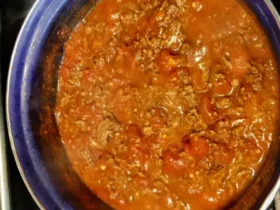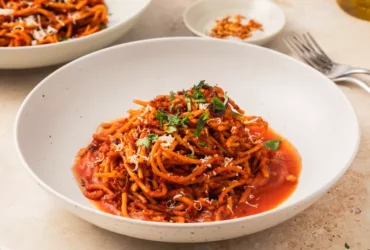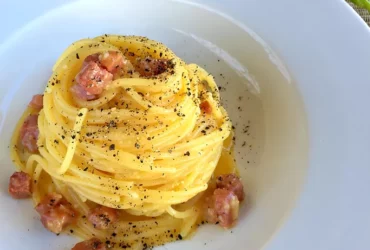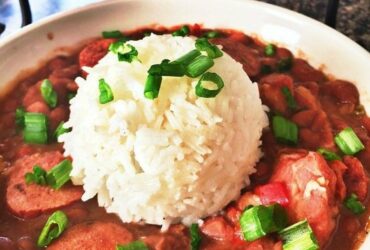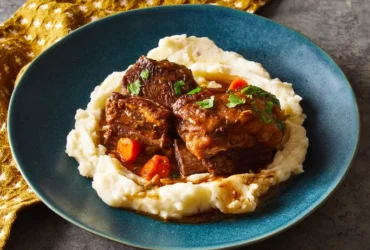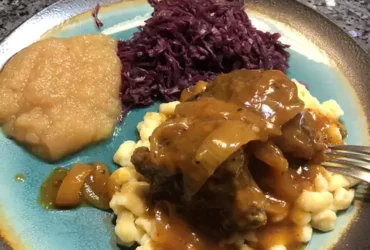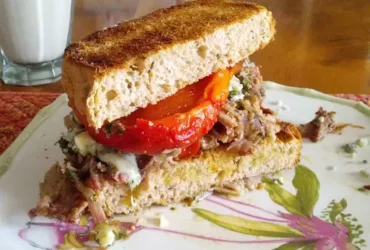Key Ingredients
Patties and Meat
The secret to creating the best hamburger ever lies in the selection and combination of key ingredients, patties, and meat.
To start with, it’s essential to choose a high-quality ground beef that is at least 80% lean to ensure juiciness and flavor.
Here are the top-grade options for ground beef:
- Ribeye: Rich in marbling, this cut provides an exceptional balance of tenderness and flavor.
- Chuck: A classic choice, chuck offers a mix of lean and fat that results in a tender yet substantial patty.
- Bold Angus: For those seeking the ultimate beef experience, bold Angus is the way to go.
Next, consider adding some finely chopped ingredients to enhance flavor and texture:
- Caramelized onions: Sweet and savory, caramelized onions bring a depth of flavor that’s simply irresistible.
- Mince garlic: A pinch of minced garlic adds an aromatic twist to the classic beef taste.
- Finely chopped bacon: Crispy and smoky, the addition of bacon creates an unforgettable combination.
Now, it’s time for the meat mixture. Combine your ground beef with some key seasonings:
- Sea salt: To preserve the natural taste and enhance the texture.
- Black pepper: The classic seasoning to balance out the flavors.
- Cayenne pepper (optional): For an extra kick of spice, add a pinch of cayenne pepper.
Don’t forget to divide the meat mixture into 4 equal portions for your patties. Make sure to handle them gently to avoid compacting the meat and losing its juiciness.
The best hamburger ever recipe calls for attention to detail, especially when shaping the patties:
- Mold each portion into a ball shape.
- Press your thumb gently in the center of each patty, making a small indentation. This will help them cook evenly and maintain their juiciness throughout.
These are the secrets behind crafting the ultimate hamburger experience with the best possible ingredients, patties, and meat.
High quality ground beef with a mix of chuck, brisket, and short rib
- The key to crafting the best hamburger ever lies in the quality of its ingredients, particularly when it comes to the meat itself.
- High-quality ground beef with a mix of chuck, brisket, and short rib provides the foundation for an unparalleled patty experience.
- A combination of these three cuts offers a balance of flavors, textures, and juiciness that elevates the burger from ordinary to extraordinary.
- The chuck portion contributes richness and depth, as it is typically composed of 20-30% fat content, which keeps the patty moist and succulent.
- The brisket adds a layer of unctuousness and an almost velvety texture, while its slightly sweet flavor complements the savory notes from the chuck.
- The short rib component brings forth an intense beefy essence and an impressive tender bite, making each mouthful feel like a luxury experience.
- By incorporating these three types of meat, you create a harmonious balance that enhances every aspect of the patty – flavor, texture, and presentation.
- This deliberate blend will make your burgers more refined and indulgent, while ensuring they retain their authentic beefy essence.
- Of course, using fresh ingredients is crucial, but having top-notch meat with a distinct composition will yield a superior product every time.
Lean to fat ratio: 70/30 or higher
The success of a great burger largely depends on the quality and balance of its ingredients, particularly when it comes to the lean to fat ratio in the meat mix.
For a truly exceptional hamburger, it’s essential to achieve a lean to fat ratio that favors flavor and juiciness without compromising texture or structure.
Key Ingredients
- Boneless Chuck (80/20 or Higher): The primary source of meat for an outstanding burger, chuck provides the perfect balance of richness, flavor, and tenderness.
- Pancetta: Adding a touch of unsmoked Italian bacon contributes depth and smokiness to the mix without overpowering it.
- Onion and Garlic Powder: Subtle additions that enhance the overall flavor without adding bulk or moisture.
Lean to Fat Ratio
The ideal lean to fat ratio for a mouth-watering burger is crucial. A minimum of 70/30, but ideally closer to 80/20, is recommended for maximum juiciness and flavor without excessive greasiness.
- Achieve the 70/30 or higher lean to fat ratio by using a combination of chuck with a high fat content (70-80%) and other ingredients that complement its richness, such as pancetta and onion powder.
Keep in mind that overmixing can result in tough burgers; therefore, mix the ingredients just enough to combine them evenly without developing gluten. This will yield a juicy and flavorful patty every time you grill or sear your burger.
Resting time for meat: at least 30 minutes in the refrigerator
The success of any hamburger recipe lies not only in the technique, but also in the quality and freshness of its key ingredients. When it comes to preparing a delicious hamburger, the type and handling of the meat are crucial factors that can make or break the dish.
For a juicy and flavorful burger, you will need high-quality ground beef with the right fat content. A good rule of thumb is to look for ground beef with at least 20% fat content, as this will ensure that your burgers remain moist and packed with flavor. You can also consider using wagyu beef or other premium options for added tenderness and richness.
It’s essential to note that the meat should be stored properly before handling to prevent spoilage and foodborne illness. Always store ground beef in a sealed container at a temperature of 40°F (4°C) or below, and use it within a day or two of purchase.
When preparing your burgers, make sure to handle the meat gently to avoid compacting it too much. Over-working the meat can lead to dense, dry burgers that are unappetizing.
The resting time for meat is also an often-overlooked but crucial aspect of preparing a great hamburger. Allowing the meat to rest in the refrigerator for at least 30 minutes before cooking will help to redistribute the fat and ensure even cooking. This process, called “ripening,” allows the enzymes within the meat to break down the proteins, making it more tender and flavorful.
During this resting time, you can also season the meat with your desired blend of spices and herbs, allowing the flavors to penetrate deeper into the meat. A simple mixture of salt, pepper, garlic powder, onion powder, and paprika is a classic starting point for many hamburger recipes.
After the resting period has elapsed, it’s time to shape your burgers and fire up the grill or grill pan. Use a light touch when handling the meat at this stage, as you want to maintain the tender texture that has been developed during the resting process.
Finally, cook your burgers over medium-high heat for 3-4 minutes per side, or until they reach an internal temperature of 160°F (71°C) for medium-rare. Let them rest again for a few minutes before serving to ensure even cooking throughout the meat.
Cooking Techniques
Grilling
- Cooking techniques play a crucial role in creating the perfect hamburger, and grilling is one of the most popular methods to achieve this goal.
- Grilling involves cooking food over direct heat, typically using charcoal or gas as the primary source of energy.
- The art of grilling lies not only in the tools you use but also in the technique itself, including how to prepare and cook your burgers for the best results.
- To begin with, it’s essential to understand that a good burger is not just about throwing some patties on the grill; it’s about creating a harmonious balance of flavors and textures.
- One of the most critical steps in grilling a hamburger is preheating your grill to the right temperature, which typically ranges from medium-high heat (375°F – 400°F) for searing the burgers to low heat (275°F – 300°F) for finishing them off.
- The ideal burger patty should be around 3/4 inch thick and made with a mixture of ground beef, salt, pepper, and any other seasonings you like.
- It’s crucial to handle the patties gently to prevent compacting them too much, which can lead to burgers that are dense and lacking in juiciness.
- When placing the patties on the grill, make sure they’re not overlapping, as this will allow for even cooking and prevent the formation of a thick, charred crust.
- Cook the first side of the burger for about 3-4 minutes or until it develops a nice sear and a hint of char around the edges.
- Flip the patty over and cook the second side for another 3-4 minutes or until it reaches your desired level of doneness, using a meat thermometer to ensure the internal temperature has reached a safe minimum of 160°F (71°C).
- Once the burger is cooked, let it rest for a few minutes before serving, allowing the juices to redistribute and the patty to retain its moisture.
- To assemble your ultimate burger, place each patty on a toasted bun, adding cheese, lettuce, tomato, onion, pickles, ketchup, and any other toppings you like in between.
Temperature control: between 375°F and 400°F
When it comes to achieving the perfect burger, temperature control plays a crucial role in cooking techniques. The ideal temperature range for cooking hamburgers is between 375°F and 400°F, as it allows for even browning and prevents overcooking.
This temperature range ensures that the patty is cooked to a safe internal temperature of at least 160°F, while still retaining its juicy texture and flavor. Cooking at temperatures below 375°F can lead to undercooked or raw patties, while cooking above 400°F can result in dry and overcooked burgers.
To achieve this precise temperature range, it’s essential to use a thermometer that can accurately measure the internal temperature of the patty. Inserting a thermometer into the thickest part of the burger will give you an accurate reading. For optimal results, try to maintain a consistent temperature within this range by adjusting the cooking time and heat as needed.
Another important aspect of temperature control is monitoring the grill or pan’s temperature. Make sure it reaches the desired temperature before adding the burgers. If using a gas grill, preheat for at least 10-15 minutes to ensure even heating. For indoor cooking, use a skillet or grill pan that can be heated to precise temperatures using an electric range or induction cooktop.
Some common mistakes when it comes to temperature control include overcrowding the grill or pan, which can lead to uneven cooking and reduced heat retention. Additionally, not allowing enough time for the burgers to cook thoroughly can result in undercooked centers.
By mastering the art of temperature control between 375°F and 400°F, you’ll be well on your way to creating the perfect hamburger every time. Remember, practice makes perfect, so keep experimenting with different temperatures and cooking times until you achieve the desired results.
Cooking duration: 45 minutes per side for mediumrare to medium
Cooking techniques are essential when it comes to creating the perfect hamburger. For a perfectly cooked burger, it’s crucial to have a good understanding of cooking techniques and how to execute them to achieve the desired level of doneness.
One of the most critical factors in achieving a perfect burger is cooking duration. The recommended cooking time for medium-rare to medium burgers is 45 minutes per side. This may seem long, but it’s essential to ensure that the burger reaches a safe internal temperature without burning the exterior.
To begin, preheat your grill or grill pan to medium-high heat. While it’s heating up, prepare your burgers by seasoning them with salt and pepper. You can also add any other seasonings you like, such as garlic powder or paprika.
Once the grill is hot, place a small amount of oil onto the grates. This will help prevent sticking and ensure that the burger releases easily once it’s cooked. Place your burgers onto the grill and cook for 45 minutes on the first side. You’ll start to see a nice crust forming on the outside of the burger.
After 45 minutes, use tongs or a spatula to carefully flip the burger over to the second side. Be gentle, as the burger is delicate at this stage. Cook for another 45 minutes, or until the internal temperature reaches your desired level of doneness.
To check the internal temperature, insert a meat thermometer into the center of the burger. For medium-rare, the internal temperature should be around 130°F – 135°F (54°C – 57°C). Medium is around 140°F – 145°F (60°C – 63°C). Make sure to avoid touching any bone or fat when taking the internal temperature reading.
Once the burger reaches your desired level of doneness, remove it from heat and let it rest for a few minutes. This will allow the juices to redistribute within the meat, making it even more flavorful and juicy.
Finally, serve your perfectly cooked burger on a toasted bun with your favorite toppings. Some classic options include lettuce, tomato, onion, pickles, cheese, ketchup, or mustard. Get creative and experiment with different combinations to find your ultimate burger!
Seared crust formation: avoid pressing down on patties with a spatula
A well-seared crust is a crucial element of a great hamburger, and it’s essential to understand how to achieve this texture without compromising the delicate balance of juices inside the patty. One common mistake many home cooks make when cooking burgers is pressing down on the patties with a spatula.
This might seem counterintuitive – after all, doesn’t pressing down help ensure even contact between the patty and the heat source? However, the truth is that pressing down can actually do more harm than good. When you press down on a burger patty, you’re applying pressure directly onto the protein fibers in the meat.
When these protein fibers are subjected to excessive pressure, they become compressed and start to squeeze out their natural juices. This not only affects the flavor of the burger but also makes it dry and tough. On the other hand, when the patty is left undisturbed while searing, the Maillard reaction can occur freely.
The Maillard reaction is a chemical reaction between amino acids and reducing sugars that occurs when food is cooked, resulting in the formation of new flavor compounds and browning. By allowing the patty to sit undisturbed during cooking, you’re giving it the opportunity to sear on its own without being interrupted.
Another reason not to press down on burger patties is that they can become misshapen or even crack open due to excessive pressure. This can expose the raw interior of the patty to heat, causing it to cook unevenly and leading to a suboptimal texture.
To achieve a perfectly seared crust on your hamburgers without pressing down with a spatula, follow these tips: preheat your grill or skillet to high heat, use a cast-iron pan if possible as it retains heat well, add a small amount of oil to prevent sticking and promote browning, cook the burgers for about 3-4 minutes per side, and resist the temptation to press down – let the patty sear naturally.
By following these tips, you’ll be able to achieve a beautiful, golden-brown crust on your hamburgers that’s both visually appealing and flavorful. Remember, it’s all about letting the Maillard reaction work its magic without interrupting the cooking process, so avoid pressing down with a spatula at all costs!
Toppings and Assembly
Lettuce, Cheese, and Condiments
The assembly of a hamburger is an art that requires attention to detail and a deep understanding of the various components involved. Among these, toppings, lettuce, cheese, and condiments play a crucial role in elevating the burger from mere mortal fare to a culinary masterpiece.
Toppings are the crowning glory of any great burger, adding texture, flavor, and visual appeal to each bite. Some popular topping options include:
- Thinly sliced onions, caramelized to bring out their natural sweetness
- Jalapeños or other hot peppers for a spicy kick
- Mushrooms, whether button, cremini, or portobello, add an earthy flavor
- Bacon, crispy and smoked, adds a savory depth to the burger
- Grilled pineapple or tomato, adding a sweet and tangy contrast
Lettuce is often the first topping to be added to the burger. Its crunchy texture provides a refreshing counterpoint to the softness of the patty. Common types of lettuce used include:
- Romaine, with its slightly bitter flavor and crisp texture
- Iceberg, providing a mild flavor and a satisfying crunch
- Mixed greens, combining various leafy varieties for added depth
Cheese is the glue that holds the burger together, binding flavors and textures in a harmonious union. Popular cheese options include:
- Cheddar, sharp or mild, adding a rich, tangy flavor
- American, melted to perfection for a creamy texture
- Mozzarella, providing a mild, milky taste and a smooth mouthfeel
Condiments are the final flourish in assembling the perfect burger. They add a burst of flavor and excitement to each bite. Common condiment options include:
- Ketchup, adding a sweet and tangy flavor
- Mustard, whether yellow or Dijon, providing a pungent kick
- Relish, offering a sweet and pickled flavor
- Sriracha or hot sauce, for those who like it spicy
In conclusion, the assembly of a great burger requires attention to detail and an understanding of the various components involved. By carefully selecting toppings, lettuce, cheese, and condiments, one can create a culinary masterpiece that delights and satisfies even the most discerning palate.
Fresh lettuce leaves: crisp iceberg or peppery arugula
The art of creating the perfect burger begins with the toppings and assembly process. When it comes to fresh lettuce leaves, you have a variety of options to choose from.
One popular choice is crisp iceberg lettuce, which provides a refreshing crunch and a mild flavor that won’t overpower the other ingredients on your burger. To use iceberg lettuce effectively, start by choosing heads that are tight and compact, with no signs of wilting or discoloration.
Rinse the leaves in cold water to remove any impurities or debris, then dry them thoroughly with a salad spinner or a clean kitchen towel to prevent sogginess. You can use iceberg lettuce as is, or get creative by adding some sliced red onion, diced tomatoes, or crumbled bacon for added flavor and texture.
On the other hand, peppery arugula offers a more robust and sophisticated alternative to iceberg lettuce. With its slightly bitter taste and delicate, almost velvety texture, arugula adds an elegant touch to your burger without overpowering it.
To use arugula effectively, choose heads that have a vibrant green color with no signs of wilting or browning. Remove any tough or fibrous stems, then gently wash the leaves in cold water to remove impurities and debris.
For both iceberg lettuce and arugula, it’s essential to handle them with care to prevent bruising and tearing. Simply tear the leaves into smaller pieces and add them to your burger as you assemble it, leaving some room for any other toppings or condiments you may want to include.
Toppings and Assembly Tips
Here are a few additional tips for building the perfect burger:
- Pile your toppings high, but not too high! Leave enough room on top of your patty for any condiments or toppings you may want to add.
- Add cheese last. Place your cheese slice (or slices) on top of the burger just before serving to melt it to perfection and create a gooey, stringy texture.
- Don’t overdo it with the toppings! Balance is key when building a great burger. Choose one or two special toppings per burger and save the rest for future burgers!
Remember, the perfect burger is all about balance and harmony between flavors, textures, and presentation. Experiment with different toppings and assembly styles to create your ultimate burger recipe.
Melted cheese options: cheddar, American, or Swiss
The perfect hamburger is all about balance and harmony between the patty, toppings, and assembly. One of the most crucial components is the melted cheese, which adds creaminess and flavor to each bite.
When it comes to choosing a type of cheese for your burger, you’re spoiled for choice with three delicious options: cheddar, American, and Swiss.
Melted Cheese Options
- Cheddar: A popular choice among cheese enthusiasts, cheddar offers a rich, tangy flavor that complements the beefy taste of the patty. Its sharpness cuts through the juiciness of the burger, creating a delightful harmony.
- american: For those who prefer a milder cheese, American is a great option. It melts smoothly and adds a touch of sweetness to each bite. Its creaminess also helps balance out the savory flavors of the burger.
- Swiss: If you want to add an international flair to your burger, Swiss is the way to go. This nutty and slightly sweet cheese pairs perfectly with the richness of the beef patty. Its creamy texture also helps keep the burger moist.
In terms of assembly, it’s essential to balance the flavors and textures on each bite. Here are some general guidelines to follow:
- Patty size: Make sure your patty is not too thick or too thin. You want it to be substantial enough to hold its own, but not so large that it overwhelms the toppings.
- Toppings ratio: Aim for a balance of textures and flavors in your toppings. A good rule of thumb is to have about 2-3 toppings per bite. This could include lettuce, tomato, onion, pickles, and cheese.
- Bun size: Choose a bun that’s sturdy enough to hold the patty and toppings in place. You don’t want your burger to fall apart as you take a bite!
By following these guidelines, you’ll be well on your way to creating the perfect hamburger ever! Remember, it’s all about balance and harmony between the patty, toppings, and assembly. Experiment with different combinations to find your ultimate burger recipe.
Condiment selection: ketchup, mustard, relish, pickles, and onions
The art of building a superior burger lies not only in its juicy patty but also in the harmonious union of toppings, condiments, and assembly. A perfectly crafted hamburger requires a thoughtful balance of flavors, textures, and presentation to elevate it from a simple meal to an unforgettable culinary experience.
When it comes to toppings, options are endless, but some essentials include crisp lettuce, ripe tomatoes, creamy mayonnaise or avocado, melted cheddar or Swiss cheese, and the all-star caramelized onions. The sweetness of the caramelized onions complements the savory flavors of the patty and other toppings, adding depth and complexity to each bite.
For condiment selection, a few timeless classics stand above the rest: ketchup, mustard, relish, pickles, and onions. A drizzle of rich ketchup adds a tangy sweetness, while a dollop of spicy mustard provides an unmistakable kick. The pungent flavor of relish – made from finely chopped cucumbers, onions, and sometimes bell peppers – adds a fresh crunch to each bite.
A sprinkle of thinly sliced pickles contributes a salty, sour taste that cuts through the richness of the burger. Thinly sliced red or yellow onions can add an oniony flavor, while sautéed onions bring a depth of sweetness to balance out the savory flavors.
To assemble the perfect burger, it’s crucial to strike the right balance between each component. Start with a sturdy bun that won’t fall apart under the weight of toppings. Next, build a solid foundation by placing the juicy patty at the base. Add a layer of lettuce and tomato for freshness, followed by cheese or avocado for creamy richness.
Top it off with your preferred combination of toppings, condiments, and onions, making sure not to overcrowd the burger. The ideal balance will create harmony between flavors, textures, and presentation, allowing each bite to be a masterful blend of sweet, savory, and tangy delight.
- Best Lusha Alternatives for 2025 - April 22, 2025
- Best Overloop Alternatives for 2025 - April 22, 2025
- Best 6sense Alternatives for 2025 - April 22, 2025


